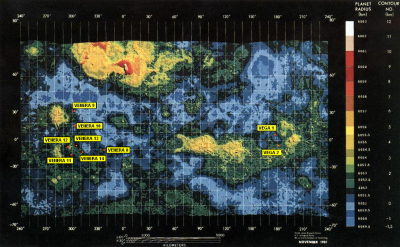Venera 5 (Russian: -5 meaning Venus 5) was a space probe in the Soviet space program Venera for the exploration of Venus.
Venera 5 was launched towards Venus to obtain atmospheric data. The spacecraft was very similar to Venera 4 although it was of a stronger design. The launch was conducted using a Molniya-M rocket, flying from the Baikonur Cosmodrome.
When the atmosphere of Venus was approached, a capsule weighing 405 kg (893 lb) and containing scientific instruments was jettisoned from the main spacecraft. During satellite descent towards the surface of Venus, a parachute opened to slow the rate of descent. For 53 minutes on 16 May 1969, while the capsule was suspended from the parachute, data from the Venusian atmosphere were returned. It landed at 3S 18E. The spacecraft also carried a medallion bearing the State Coat of Arms of the Soviet Union and a bas-relief of Lenin to the night side of Venus.
Given the results from Venera 4, the Venera 5 and Venera 6 landers contained new chemical analysis experiments tuned to provide more precise measurements of the atmosphere's components. Knowing the atmosphere was extremely dense, the parachutes were also made smaller so the capsule would reach its full crush depth before running out of power (as Venera 4 had done).
The Venera (Russian: Вене́ра, pronounced [vʲɪˈnʲɛrə], which means "Venus" in Russian) program was the name given to a series of space probes developed by the Soviet Union between 1961 and 1984 to gather information about the planet Venus. Ten probes successfully landed on the surface of the planet, including the two Vega program and Venera-Halley probes, while thirteen probes successfully entered the Venusian atmosphere. Due to the extreme surface conditions on Venus, the probes could only survive for a short period on the surface, with times ranging from 23 minutes to two hours.
The Venera program established a number of precedents in space exploration, among them being the first human-made devices to enter the atmosphere of another planet (Venera 3 on 1 March 1966), the first to make a soft landing on another planet (Venera 7 on 15 December 1970), the first to return images from another planet's surface (Venera 9 on 8 June 1975), the first to record sounds on another planet (Venera 13 on 30 October 1981), and the first to perform high-resolution radar mapping scans (Venera 15 on 2 June 1983).

1969May, 16
Venera program: Venera 5, a Soviet space probe, lands on Venus.
Choose Another Date
Events on 1969
- 2Mar
Concorde
In Toulouse, France, the first test flight of the Anglo-French Concorde is conducted. - 17Apr
Robert F. Kennedy
Sirhan Sirhan is convicted of assassinating Robert F. Kennedy. - 16Jul
Apollo 11
Apollo program: Apollo 11, the first mission to land astronauts on the Moon, is launched from the Kennedy Space Center at Cape Kennedy, Florida. - 20Jul
Apollo 11
Apollo program: Apollo 11's crew successfully makes the first manned landing on the Moon in the Sea of Tranquility. Americans Neil Armstrong and Buzz Aldrin became the first humans to walk on the Moon (July 21 UTC). - 30Jul
Richard Nixon
Vietnam War: US President Richard Nixon makes an unscheduled visit to South Vietnam and meets with President Nguyễn Văn Thiệu and U.S. military commanders.

 English
English  español
español  français
français  português
português  русский
русский  العربية
العربية  简体中文
简体中文 